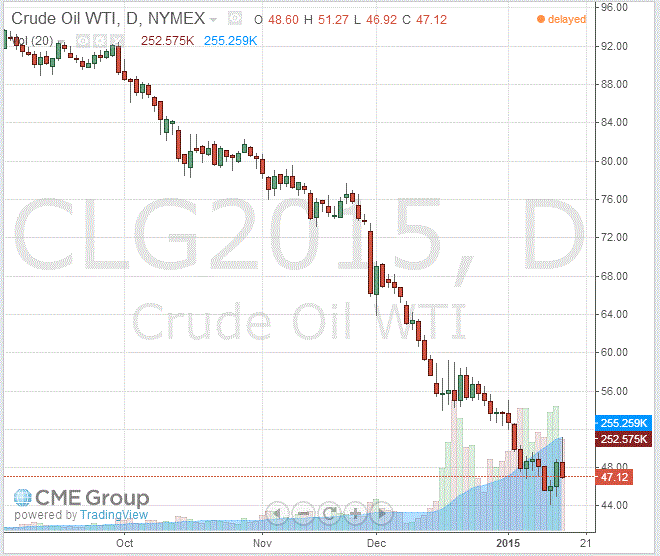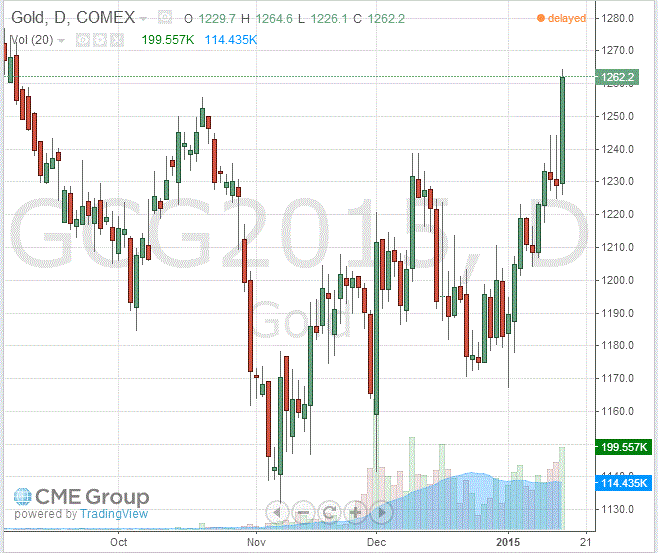Noticias del mercado
-
17:41
Oil: a review of the market situation
Oil prices continued to fall after yesterday's rally, which is associated with an increase in demand on the world market, as well as new forecasts from the Bank of America Merrill Lynch.
As it became known, experts today BOAML lowered its forecast for the price of Brent crude oil at the end of the first quarter of 2015 to $ 31 per barrel
Recall concerns about weakening global demand, coupled with forecasts that the Organization of Petroleum Exporting Countries will not cut production to support oil market, putting pressure on prices in recent months.
The course of trade also influenced the report from OPEC, which lowered the forecast demand for oil cartel in 2015 to 100 thousand. / Sec - to 28.8 million b / d. The main factor in reducing the demand for oil has become the price of oil, which was below expectations, the report said. In December, OPEC has reduced the forecast of demand for crude oil delivered by the cartel, 2015 to 300 thousand. Barrels per day compared to the previously expected index, to 28.9 million b / d. This figure is the lowest since 2003, OPEC believed that global demand next year will grow by 1.2% - up to 92.26 million b / d, an increase of 70 thousand. B / d lower than the previous forecast. In addition, the report of the organization said that the total oil reserves in the developed economies in October amounted to 2.7 billion barrels, or 15 million barrels higher than the average for the past 5 years.
Also, market participants continue to analyze yesterday's Beige Book report. It noted that the decline in energy prices hit the US oil and gas producers, forcing some companies to lay off workers, while others can not get loans.
Many regulators, investors and economists believe that cheap oil and petroleum products in general are beneficial for the US economy, allowing households to spend more money on other products.
In the "beige book" The Fed's monthly report on business activity in the country, according to the testimony of some of the economic recovery. Companies report the Fed - the central bank of the country - that low gasoline prices increased sales of goods in the Chicago area during the holidays and gave people the opportunity to buy cars in the larger district of Atlanta. But the Fed also has a long list of problems caused by more than 50 percent collapse in oil prices since mid-June.
The cost of the February futures on US light crude oil WTI (Light Sweet Crude Oil) dropped to 47.11 dollars per barrel on the New York Mercantile Exchange.
February futures price for North Sea Brent crude oil mix fell $ 0.33 to $ 48.30 a barrel on the London Stock Exchange ICE Futures Europe.
-
17:20
Gold: a review of the market situation
Gold prices rose today by more than two percent, reaching at this 4-month high, which was associated with an unexpected decision by the Swiss Central Bank to abandon the peg franc. In addition, the SNB lowered the rate on demand deposits to 0.75%.
Gold prices rose nearly 6 percent this month, after declining for two consecutive years, but the forecast for the current year remains uncertain.
"Gold demand in the background of the situation, because no one expected that the Swiss central bank to abandon the peg. This caused a noticeable fluctuations in the market, and obviously led to a flight to safe assets," - said the expert Saxo Bank Ole Hansen.
It is worth emphasizing, lower interest rates positive effect on gold, because it lowers the relative cost containment metal that guarantees investors a profit.
Meanwhile, the weakness of the dollar is also supporting gold, as it boosts the metal's appeal as an alternative asset and decreases in the value of dollar-denominated commodities for holders of other currencies.
A little pressure on gold have data on the United States. As shown by Philadelphia Fed report, in January PMI deteriorated markedly, reaching at this level 6.3 points compared to 24.5 points in December. It is worth noting that many economists expected a decline of this indicator only to the level of 20.3. All sub-indices fell in January: the index terms of delivery in January fell to -11.0 vs. -0.2 in December, the shipments index to -6.9 from 15.1, the new orders index to 8.5 from 13.6 in December, the index of inventories to 0.7 from 7.3, the employment index to -2.0 from 8.4 in December, the index of wholesale prices in January -0.2 against 9.8 in December, and the index purchase prices up 9.8 against 14.4 in December
We also add that previously reported showed that the number of Americans who first applied for unemployment benefits rose to its highest level in four months last week, noting a slight decline in the labor market, which has just published its strongest year for more than ten years. Initial claims for unemployment benefits rose by 19,000 and amounted to a seasonally adjusted 316,000 in the week ended January 10th. Economists had expected 299,000 new claims.
The cost of the February gold futures on the COMEX today rose to 1262.20 dollars per ounce.
-
12:20
Oil: Prices extend fall on record output
Brent crude and West Texas Intermediate extended losses on Thursday being negative for the last straight seven weeks. Brent Crude lost -2.44%, currently trading at USD47.50 a barrel. West Texas Intermediate declined by -1.40% currently quoted at USD47.80 as Iraq announced to further boost its exports to a record level.
The global glut continues in 2015 and a low global demand weighs amid record output from U.S. shale drillers - U.S. crude production increased by 60,000 barrels a day last week according to the EIA and stockpiles expanded. Both major brands lost more than 50% of their value since mid-2014 but the OPEC, responsible for 40% of worldwide oil-production, decided to leave output-rates unchanged around 30 million barrels a day and repeatedly reaffirmed not to change policy in the fight for market share. Record Russian output not seen since the end of the Soviet Union further adds to the downward pressure on oil prices.
-
12:02
Gold at new 12-week high after SNB decision to lower interest rates and discontinue minimum exchange rate
Gold prices rose sharply close to highs from October 21st 2014 at USD1,254.90 after SNB decided to discontinue the minimum exchange rate of 1.20 per euro and lowered interest rates more into negative territory to -0.75. Yesterday the precious metal already hit a new high at USD1,244.10 intraday but lost afterwards. The precious metal is currently quoted at USD1,248.20, +1,49% a troy ounce.
After gold posted an drop last year for the first time since 2000 HSBC Securities (USA) Inc. sees prices raise in 2015 as Asian consumption rises and investors return to exchange traded products physically backed by the metal. Still, a strong U.S. dollar backed by solid economic growth in the U.S. weighs on the dollar-nominated metal as it becomes more expensive for holders of other currencies.
GOLD currently trading at USD1,248.20
-
10:20
Press Review: Wall Street Now Sees Oil Around $40
REUTERS
India makes surprise early rate cut, hints at more
(Reuters) - The Reserve Bank of India surprised markets with a 25 basis point reduction in interest rates on Thursday and signaled it could cut further, amid signs of cooling inflation and what it said was a government commitment to contain the fiscal deficit.
While the early move was unexpected, aggressive reductions in rates have been seen as likely over the course of the coming year to help India's economy out of a rut, with growth rates struggling to recover from their weakest levels since the 1980s.
Source: http://www.reuters.com/article/2015/01/15/us-india-cenbank-idUSKBN0KO0DJ20150115
BLOOMBERG
Wall Street Now Sees Oil Around $40
Brace for $40-a-barrel oil.
The U.S. benchmark crude price, down more than $60 since June to below $45 yesterday, is on the way to this next threshold, said Societe Generale SA and Bank of America Corp. And Goldman Sachs Group Inc. says that West TexasIntermediate needs to remain near $40 during the first half to deter investment in new supplies that would add to the glut.
"The markets are continuing to price in huge oversupply in the first half of 2015," Mike Wittner, head of research at Societe Generale SA in New York, said by phone on Jan. 12. "We're going to go below $40."
Source: http://www.bloomberg.com/news/2015-01-14/oil-at-40-and-below-gaining-traction-on-wall-street.html
BLOOMBERG
What, Us Worry? Economists Stay Upbeat as Markets See Trouble
The U.S. consumer, that dynamo of the global economy, just took a step back.
Relax. It's not that bad, economists say.
News Wednesday that U.S. retail sales unexpectedly declined in December reverberated through financial markets, but few economists read the report as a sign of trouble for the nation's economy.
In fact, many economists say the U.S. economy is doing just fine.
So why did the markets react the way they did? The answer, in part, is that the report added to a wall of worry confronting investors. Topping the 2015 angst-list are the plunge in oil and other commodities, as well as slowdowns in China and Europe.
-
00:32
Commodities. Daily history for Jan 14’2015:
(raw materials / closing price /% change)
Light Crude 48.62 +0.29%
Gold 1,229.10 -0.44%
-


